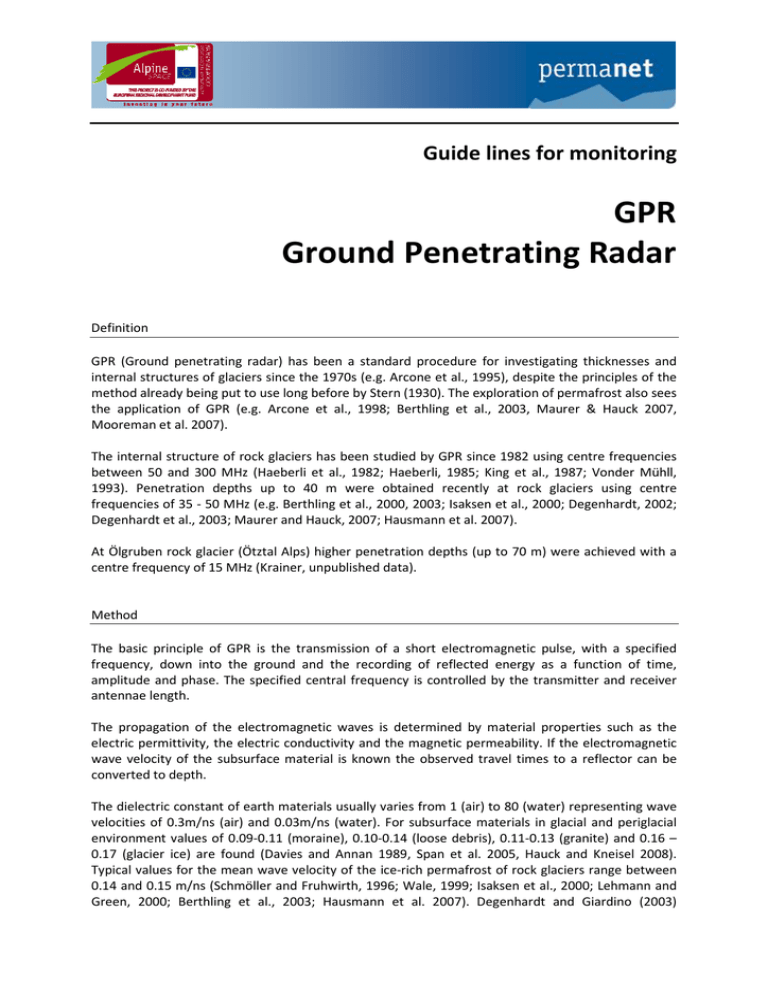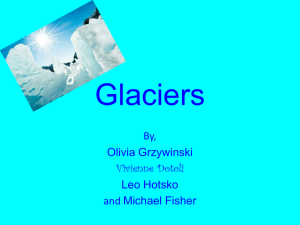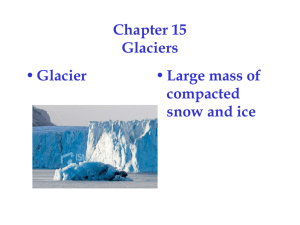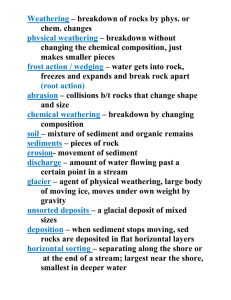GPR Ground Penetrating Radar
advertisement

Guide lines for monitoring GPR Ground Penetrating Radar Definition GPR (Ground penetrating radar) has been a standard procedure for investigating thicknesses and internal structures of glaciers since the 1970s (e.g. Arcone et al., 1995), despite the principles of the method already being put to use long before by Stern (1930). The exploration of permafrost also sees the application of GPR (e.g. Arcone et al., 1998; Berthling et al., 2003, Maurer & Hauck 2007, Mooreman et al. 2007). The internal structure of rock glaciers has been studied by GPR since 1982 using centre frequencies between 50 and 300 MHz (Haeberli et al., 1982; Haeberli, 1985; King et al., 1987; Vonder Mühll, 1993). Penetration depths up to 40 m were obtained recently at rock glaciers using centre frequencies of 35 - 50 MHz (e.g. Berthling et al., 2000, 2003; Isaksen et al., 2000; Degenhardt, 2002; Degenhardt et al., 2003; Maurer and Hauck, 2007; Hausmann et al. 2007). At Ölgruben rock glacier (Ötztal Alps) higher penetration depths (up to 70 m) were achieved with a centre frequency of 15 MHz (Krainer, unpublished data). Method The basic principle of GPR is the transmission of a short electromagnetic pulse, with a specified frequency, down into the ground and the recording of reflected energy as a function of time, amplitude and phase. The specified central frequency is controlled by the transmitter and receiver antennae length. The propagation of the electromagnetic waves is determined by material properties such as the electric permittivity, the electric conductivity and the magnetic permeability. If the electromagnetic wave velocity of the subsurface material is known the observed travel times to a reflector can be converted to depth. The dielectric constant of earth materials usually varies from 1 (air) to 80 (water) representing wave velocities of 0.3m/ns (air) and 0.03m/ns (water). For subsurface materials in glacial and periglacial environment values of 0.09-0.11 (moraine), 0.10-0.14 (loose debris), 0.11-0.13 (granite) and 0.16 – 0.17 (glacier ice) are found (Davies and Annan 1989, Span et al. 2005, Hauck and Kneisel 2008). Typical values for the mean wave velocity of the ice-rich permafrost of rock glaciers range between 0.14 and 0.15 m/ns (Schmöller and Fruhwirth, 1996; Wale, 1999; Isaksen et al., 2000; Lehmann and Green, 2000; Berthling et al., 2003; Hausmann et al. 2007). Degenhardt and Giardino (2003) PermaNET – Guide lines for monitoring produced a different value (0.12 m/ns). Best results are achieved when GPR measurements are combined with other geophysical methods such as seismics or gravimetry (e.g. Hausmann et al. 2007). Survey Design The design of GPR measurements should include the following information: - Antenna type and centre frequency - Antenna spacing (distance between transmitter and receiver) - Orientation of antennas with respect to the profile - Measuring mode (point, continuous) - Recording parameters (range, filter, etc.) - Measuring conditions (on snow pack in winter or during summer) - Determination of electromagnetic wave velocity (CMP, diffraction hyperbolae) Since rock glaciers are usually located close to steep rock walls shielded antennae would be preferred to suppress wave events. For active layer studies on rock glaciers shielded 200 MHz antenna are suggested whereas for studies focusing on the (internal) structure of rock glacier multiple low frequency antennae with 35 MHz (depth <= 30 m) or 15 MHz (depth > 30 m) are recommended (Hausmann, pers. comm.). For the latter one air wave events might be recorded which are characterized by velocities of 0.3 m/ns (point source) or 0.15 m/ns (linear event). To maximize target coupling antennas should be separated by a distance of 20% of the target depth (Annan, 2001). Due to operational logistics an antenna spacing of 4 m was found to be optimum for a 40 MHz antenna. For application on rock glaciers antennas oriented perpendicular to the profile direction are favored. Measurements with orthogonal antenna configuration could provide additional information on the internal structures (e.g. direction of crevasses). In general only the point modus (vertical stacking >= 64) can be applied due to the steep and rough terrain of the rock glaciers. The spatial sample interval is closely linked to the central operating frequency and the dielectric properties of the subsurface (Annan, 2001). In order to assure the ground response is not aliased the Nyquist frequency should not be exceeded. Thus for ice-rich permafrost (dielectric constant ~4) the spatial sample interval has to be at least 1.1 m for a 35 MHz and 2.5 m for a 15 MHz antenna. The temporal sample interval is also controlled by the Nyquist sampling concept and should be at most half the period of the highest frequency signal in the record. Thus the maximum sample interval is 4.76 ns for a 35 MHz antenna. The range defines the time window in nanoseconds (ns) that will record reflections from a single pulse and should be specified according to the exploration depth and the wave velocity of the subsurface material. For example the specified ranges for two subsurfaces (30 m thick) have to be at least 780 ns for a moraine (v=0.1 m/ns) and 465 ns for a glacier (v=0.168 m/ns). If the record is filtered during the survey the operator has to ensure that the received frequency from the subsurface is not affected by the filter setting. As an example: If we expect a frequency response between 20 and 50 MHz the filter has to be defined by 5 MHz (high pass) and 150 MHz (low pass). GPR surveys on rock glaciers are best conducted during winter or in early spring when a thick snow cover has build up. This cold weather conditions reduce signal attenuations from the active layer. The field design commonly includes longitudinal profiles measured along the axis of a rock glacier and transverse profiles measured perpendicular to the flow direction of the rock glacier. For the time to depth conversion as well as to interpret the subsurface by its physical properties information on the (mean) subsurface wave velocity is required. This data is either provided by the observation of Ground Penetrating Radar diffraction hyperbolas or by Common Midpoint Measurements (CMP). The CMP method is used to obtain an estimate of the signal velocity versus depth by varying the antenna spacing at a fixed location. Fig. 1 and 2: GPR measurements on rock glaciers. References Annan AP. 2001. Ground Penetrating Radar Workshop Notes. Sensors & Software Inc. Arcone SA, Lawson DE, Delaney AJ. 1995. Short-pulse radar wavelet recovery and resolution of dielectric contrasts within englacial and basal ice of Matanuska Glacier, Alaska, USA. Journal of Glaciology 41(137): 68-86. Arcone SA, Lawson DE, Delaney AJ, Strasserz JC, Strasser JD. 1998. Ground-penetrating radar reflection profiling of groundwater and bedrock in an area of discontinuous permafrost. Geophysics Vol. 63, No. 5: 1573-1584. PermaNET – Guide lines for monitoring Berthling I, Etzelmüller B, Isaksen K, Sollid JL. 2000. Rock Glaciers on Prins Karls Forland. II: GPR Soundings and the Development of Internal Structures. Permafrost and Periglacial Processes 11: 357–369. Berthling I, Etzelmu¨ller B, Wale M, Sollid JL. 2003. Use of Ground Penetrating Radar (GPR) soundings for investigating internal structures in rock glaciers. Examples from Prins Karls Forland, Svalbard. Zeitschrift für Geomorphologie Suppl. 132: 103–121. Degenhardt JJ. 2002. A model for the development of a lobate alpine rock glacier in southwest Colorado, USA: Implications for water on Mars. PhD thesis, Texas A&M University. Available: http://repositories.tdl.org/handle/1969.1/320 [6 October 2007]. Degenhardt JJ, Giardino JR. 2003. Subsurface investigation of a rock glacier using groundpenetratingradar: Implications for locating stored water on Mars. Journal of Geophysical Research 108 E4: 8036, doi:10.1029/2002JE001888. Degenhardt JJ, Giardino JR, Junck MB. 2003. GPR survey of a lobate rock glacier in Yankee Boy Basin, Colorado, USA. In Ground Penetrating Radar in Sediments, Bristow CS, Jol HM(eds). Geological Society: London; Spec. Publ. 211: 167–179. Copyright # 2007 John Wiley & Sons, Ltd. Permafrost and Periglac. Process., 18: 351–367 (2007), DOI: 10.1002/ppp Haeberli W. 1985. Creep of Mountain Permafrost: Internal Structure and Flow of Alpine Rock Glaciers. Mitteilungen der Versuchsanstalt für Wasserbau, Hydrologie und Glaziologie ETH Zuürich 77: 1–142. Haeberli W, Waächter HP, Schmid W, Sidler C. 1982. Erste Erfahrungen mit dem US Geological Survey Monopuls Radioecholot im Firn. Eis und Permafrost der Schweizer Alpen. Mitteilungen der Versuchsanstalt für Wasserbau, Hydrologie und Glaziologie ETH Zürich, Arbeitsheft 6: 1–23. Hausmann, H., Krainer, K.; Brückl, E., & Mostler, W., 2007a. Internal structure, composition and dynamics of Reichenkar rock glacier (western Stubai Alps, Austria). – Permafrost and Periglacial Processes 18: 351-367. DOI: 10.1002/ppp.60. Isaksen K, Ødegard RS, Eiken T, Sollid JL. 2000. Composition, flow and development of two tongueshaped rock glaciers in the permafrost of Svalbard. Permafrost and Periglacial Processes 11: 241–257. King L, Fisch W, Haeberli W, Waechter HP. 1987. Comparison of resistivity and radio-echo soundings on rockglacier permafrost. Zeitschrift für Gletscherkunde und Glazialgeologie 23(1): 77–97. Maurer H, Hauck C. 2007. Geophysical imaging of alpine rock glaciers. Journal of Glaciology 53(180): 110–120. Moorman BJ, Robinson SD, Burgess MM. 2007. Imaging near-surface permafrost structure and characteristics with Ground-Penetrating Radar. CSEG Recorder 23-30. Schmoöller R, Fruhwirth R. 1996. Komplexgeophysikalische Untersuchungen auf dem Dösener Blockgletscher (Hohe Tauern, Österreich). Beiträge zur Permafrostforschung in Österreich, Graz, Band 33. Span N, Fischer A, Kuhn M, Massimo M, Butschek M. 2005. Radarmessungen der Eisdicke österreichischer Gletscher. Zentralanstalt für Meteorologie und Geodynamik Band 1: 0-145. Stern W. 1930. Über Grundlagen, Methodik und bisherige Ergebnisse elektrodynamischer Dickenmessungen von Gletschereis. Zeitschrift für Gletscherkunde und Glazialgeologie 15: 2442. Vonder Mühll D. 1993. Geophysikalische Untersuchungen im Permafrost des Oberengadins. Diss. ETH No. 10107, 110pp. Mitteilungen der Versuchsanstalt für Wasserbau, Hydrologie und Glaziologie: Zürich, Switzerland. Ground Penetrating Radar Wale M. 1999. Indre strukturer i utvalgte steinbreer pa Svalbard. MSc thesis, Department of Physical Geography,University of Oslo. Version 1 – 1.02.2010 – H. Hausmann & K. Krainer






